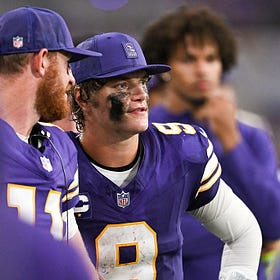J.J. McCarthy and the Rest of the Season: How Much Can We Tell From His First Two Starts?
Regardless of the Carson Wentz injury news, it was clear that J.J. McCarthy would be the Minnesota Vikings starter going forward. His first two starts were dire. But how much does that really tell us?
The announcement that Carson Wentz needs surgery and has been placed on injured reserve didn’t change much in the universe of the Minnesota Vikings; fans expected the starter in Week 9 against the Detroit Lions, and for the rest of the season going forward, to be J.J. McCarthy.
But the Wentz news — expected after seeing the pain he was in during the Thursday Night Football loss to the Los Angeles Chargers — means that there’s no longer a floor. There’s no going back to something that might be better, no matter how frustrating that “better” might be.
This isn’t unusual across the NFL for many starters, but many teams have a veteran backup or bridge if they have a promising first- or second-year player. This year, Jaxson Dart was accompanied by two veteran quarterbacks in Russell Wilson and Jameis Winston.
Last year, that was Jarrett Stidham in Denver, Marcus Mariota in Washington, Kirk Cousins in Atlanta and Jacoby Brissett in New England.
And Sam Darnold was the bridge to J.J. McCarthy. But, heading into year two, there’s no fallback plan if the quarterback cannot perform — a situation the Vikings bought into when they entered training camp without a viable backup option.
So, there’s no parachute. Is that concerning?
If one wants to win this season, probably. Worrying about that might be a bit much; even if he turns out to be an outstanding quarterback for the balance of the year, it will be difficult to engineer the approximately 7-3 record the Vikings will need to climb out of their hole to make the playoffs.
That said, NFL.com estimates an 11 percent probability that the Vikings make the playoffs. ESPN’s FPI estimate is at 4.8 percent, while FTN Fantasy projects a 2.4 percent probability.
Fighting on a ten percent probability is pretty easy to understand, but fighting on a two percent probability is a bit tougher. If one agrees with FTN, then it might not matter much that there’s not much of a floor for quarterback play in Minnesota.
And that seems to reflect the fanbase's general sentiment. NFL teams will never admit that a season is “about developing a young quarterback” instead of winning games, but fans aren’t holding out much hope that McCarthy will lead the Vikings to the playoffs this year.
McCarthy and the Development Path
At the moment, McCarthy needs development.
Quarterback Controversy: Charting J.J. McCarthy and Carson Wentz to Find the Vikings Starter
Now that the Minnesota Vikings have returned from their European trip and completed their bye week, one thing is on every Viking fan’s mind — who will start on Sunday against the Philadelphia Eagles, J.J. McCarthy or Carson Wentz?
The degree to which McCarthy lags behind the rest of the league in production statistics has been well discussed, so it’s worth focusing for a moment on the traits he will need to make progress on.
In short, his mechanics need continuous improvement. Overrotation on his throws has led to deep-ball inaccuracy and his footwork coming out of the drop de-syncs his timing with receivers.
On top of that, McCarthy needs to quicken his process and evaluate the play as it develops with more rapidity. He also tends to drift in the pocket, leading to easier angles for opposing pass rushers and complicating offensive line play.
It seems as if McCarthy’s judgment of the speed of the game isn’t quite there yet; he underestimates the time it takes for defenders to close on the ball in the air and also has some issue gauging his speed against players disrupting the pocket.
Anticipation can be a problem for McCarthy, a product of his timing issues. Overall accuracy — especially ball placement to maximize yards after catch — is a big part of his development cycle.
None of these are unique to McCarthy, and his weaknesses overlap significantly with Wentz’s. Rather, it’s an indication that the road to improvement is long.
Because so many of these involve issues stemming from footwork — footwork that had been a focus of his development process so far — there’s reason to believe the Vikings held McCarthy out of games because the injury could interfere with his emerging biomechanics.
Luke Braun explained some of the footwork issues J.J. McCarthy needs to work on. More in this piece.
As O’Connell explained to the media during the bye week about how McCarthy was practicing, “It was great to get back on the grass and have some good sessions out there, kind of getting back to a lot of the principles of lower-body mechanics and things that had been really good parts of his early journey here.”
He added, “Quarterback play is about the foundation of getting to that premier base and body position at the top of your drop, whatever that drop is.”
“That could be quick game, that could be a five-, seven-step drop. That can be a play-action pass where you turn your back to the defense,” he said. “Whatever it is, you’re still getting to that optimal position at the top of your drop, so then you can read with your feet and eyes tied together and play in rhythm.”
An injury that many players can generally play through — the pain from recovering from a high-ankle sprain, for example — may inhibit a specific player based on his particular development needs.
Regardless, the production McCarthy has put up thus far has been concerning. Of all quarterbacks who have had their first two starts in the same season since 2000, his EPA per play is in the 3.9th percentile. How much does that matter?
The History of Slow Starts
We know that two starts is not nearly enough information to have about a quarterback to say much about the rest of his career. It’s a pitifully small sample — one so small we’re parsing a fraction of an already-known poor sample, a quarterback’s first year.
It is, instead, an attempt to determine whether we can learn anything at all from those two starts — first, for career trajectories, and second, for rest-of-season performance.
It’s not an accident, for example, that Philip Rivers’ first two starts were outstanding, or that Robert Griffin III and Aaron Rodgers lit up the league. Patrick Mahomes famously burst onto the scene as an overwhelmingly productive player in his second year.
But the leader in EPA per dropback in his first two starts is Chad Pennington, followed by Kyle Allen, Colin Kaepernick and Tim Rattay. While one could reasonably make arguments excusing the career trajectories of Pennington (injury) and Kaepernick (uh… stuff), it’s pretty clear that a sample that boosts No. 6 overall performer Case Keenum or No. 8 overall performer Austin Davis isn’t doing us a ton of favors from an information perspective.
At the bottom of the ranks, we see players like Matthew Stafford, Jared Goff, Alex Smith, and, maybe less convincingly to some, Eli Manning, Jay Cutler and Bo Nix.
Nevertheless, it broadly points in the right direction. In the top 25 of 237 qualifying quarterbacks are Rivers, Mahomes, Rodgers, Griffin, Tony Romo and Dak Prescott.
The aggregate data suggests as much, though the relationship between performance in a player’s first two games and their career outcomes was stronger than I had anticipated.
It is difficult to find a notable quarterback with a good career trajectory whose performance in his first two games fell below the 40th percentile in performance. Even famous slow starter Josh Allen (whose games following his initial two starts were much worse) placed well above the NFL average.
At minus-0.52 EPA per play, McCarthy’s not close to anyone on the list, though there is one quarterback below him: Alex Smith, whose career didn’t take off until his seventh year in the league.
The Mismeasure of Quarterback
To measure career outcomes, I initially looked at career EPA per dropback. The results were fairly weak, and I noticed a critical error: many quarterbacks who had reasonable EPA per play had been benched quickly before they could really “correct course” and reveal their true, worse, talent level.
For example, Nick Mullens leads quarterbacks in career EPA per play but has not earned a starting job anywhere he’s been.
Matt Schaub, Patrick Ramsey, Ryan Fitzpatrick, Shaun Hill and others were marked as above-average quarterbacks by this metric despite the fact that multiple teams had generally deemed these players to be backups—even in unusual cases like Schaub and Fitzpatrick, this hardly seemed appropriate.
So, the next approach gave quarterbacks a penalty for every game they didn’t start in the ten years since they entered the NFL draft if they started fewer than 160 games in their career. Mahomes earns a small penalty this way (one he will, by the end of his career, erase), as does Tony Romo.
Keep reading with a 7-day free trial
Subscribe to Wide Left to keep reading this post and get 7 days of free access to the full post archives.





